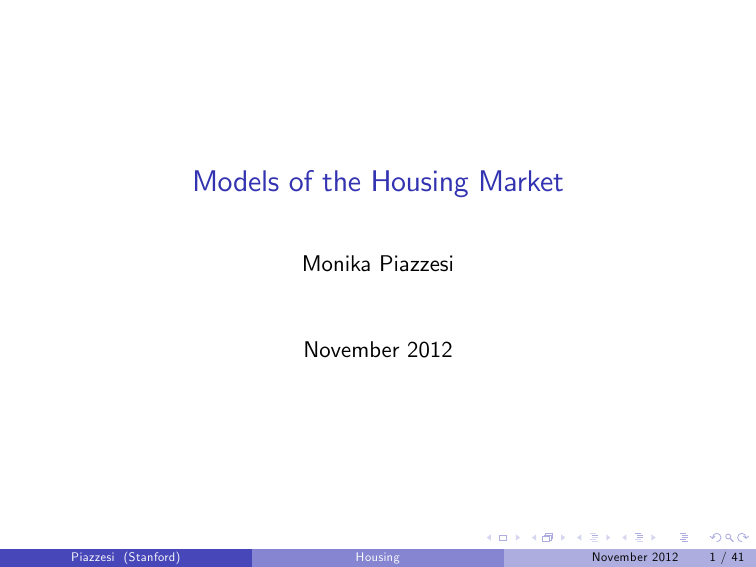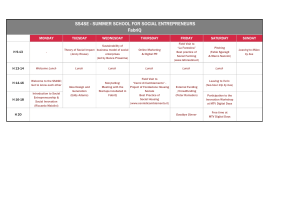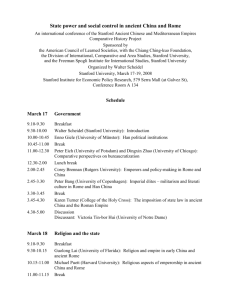Models of the Housing Market
advertisement

Models of the Housing Market Monika Piazzesi November 2012 Piazzesi (Stanford) Housing November 2012 1 / 41 The macro…nance of housing workhorse models in macro have one capital stock, one consumption good …rms face frictions (e.g., Bernanke-Gertler) recent episode dramatic increase in leverage by households housing as di¤erent capital stock & consumption good households face frictions Piazzesi (Stanford) Housing November 2012 2 / 41 Two Examples assignment model gets at the cross section of house prices search model gets at volume and price impact of few optimists Piazzesi (Stanford) Housing November 2012 3 / 41 Cross Section of House Prices models with housing capital 1. determine the per unit price of housing capital ) same % capital gains on all houses 2. Euler equations of all households determine the per unit price (marginal) user cost = MRS of housing and other goods ) price changes only if all households are a¤ected (e.g., need to a¤ect Bill Gates) Piazzesi (Stanford) Housing November 2012 4 / 41 Repeat sales 2000 - 2005; repeat sales fitted value 30 capital gain 2000-5 , % p.a. San Diego County, CA 25 20 15 10 5 0 -5 200 400 600 800 1000 1200 House Value in 2000 (thousands of dollars) Piazzesi (Stanford) Housing November 2012 5 / 41 Assignment model for the cross section model with housing capital does not provide an explanation. Landvoigt, Piazzesi & Schneider 2012: model with indivisible houses that di¤er by quality I prices solve assignment problem: 1 house - 1 mover (marginal) user cost of housing = MRS of other goods for housing I di¤erent marginal investor for every house quality ) capital gains di¤er by quality; depend on house, mover distributions I quantitative implementation for San Diego County, 2000-5 higher capital gains for low quality houses since 1 2 more low quality houses transacted in 2005 ) at low qualities: richer marginal investors, high marg. user costs lower interest rate & downpayment requirements ) a¤ects poor households’marginal user cost more Piazzesi (Stanford) Housing November 2012 6 / 41 Price impact of a small number of optimistic traders Michigan survey: small number of households who were optimistic about future house prices, doubled during the early 2000s standard …nance story (Miller 1977) : stock market no short sales but otherwise frictionless =) few wealthy optimists drive up prices by buying up all assets high volume: over 100% in stock market does this apply to the housing market? transaction costs, search, non-standardized asset, indivisible low volume: 6% in the housing market Piazzesi (Stanford) Housing November 2012 7 / 41 Search model for the housing market Piazzesi & Schneider 2011: search market: few transactions recorded price = transaction price =) few (not wealthy) optimists can drive up prices with small increase in volume House prices in a search model are di¤erent from the standard frictionless makret. [Application here: search with heterogeneous beliefs] Piazzesi (Stanford) Housing November 2012 8 / 41 Related Literature models with indivisible houses Kaneko 1983, Ortalo-Magne & Rady 2006, Rios-Rull & Sanchez-Marcos 2008, Caplin & Leahy 2010 facts on cross section of house prices within cities Poterba 1991, Case & Mayer 1996, Case & Shiller 2005, Guerrieri, Hartley & Hurst 2009 credit & house prices Lamont & Stein 1999, Mian & Su… 2009, 2010 models of recent boom with divisible housing capital Himmelberg & Mayer 2005, Kahn 2008, Kiyotaki, Michaelides & Nikolov 2008, Favilukis, Ludvigson & Van Nieuwerburgh 2010 Chatterjee & Eyigungor 2009, Glaeser, Gottlieb & Gyourko 2010 Piazzesi (Stanford) Housing November 2012 9 / 41 Overview Model structure: houses meet movers two goods: housing & “other” (numeraire) quality index h 2 [0, 1] G (h ) cdf of house qualities traded price function p (h ), p (0) = 0 mover i’s demand h (p, i ) in equilibrium Pr (h (p, i ) h ) = G (h ) Plan: 1 simple version 2 quantitative model Piazzesi (Stanford) Housing November 2012 10 / 41 Simple model One mover characteristic: cash on hand w , cdf F (w ) optimization problem, with v indirect utility over other good, housing max v (w h p (h ) , h ) consider equilibrium with house quality strictly increasing in wealth equilibrium assignment of wealth w (h ) to quality h s.t. markets clear F (w (h )) = G (h ) ) w (h ) = F 1 (G (h)) asset pricing from Euler equations for all h p 0 (h ) = v2 (w (h ) v1 p (h ) , h ) di¤erent marginal investor w (h ) for every house h 2 [0, 1] Piazzesi (Stanford) Housing November 2012 11 / 41 Special case: linear pricing given v , F and avg quality H̄, there is a cdf G with mean H̄ s.t. the price function is linear p (h ) = p̄h, and for all h p̄ = v2 (w (h ) v1 p (h ) , h ) , w (h ) = F 1 (G (h)) (every investor w (h ) marginal for every house h 2 [0, 1]) macro models with divisible housing capital I I I assume that house cdf G adjusts to ensure linear pricing marginal rate of transformation between house types = 1 per unit price p̄ changes if and only if MRSs of all investors change idea: I I I take house distribution G directly from the data don’t take a stand on supply side under observed G , price may change locally with MRS at quality h Piazzesi (Stanford) Housing November 2012 12 / 41 Special case: log utility & polynomial assignment v separable log in housing, other resources: v (c, h ) = log c + θ log h equilibrium price function p 0 (h ) = θ (w (h ) Euler equations ) linear di¤erential equation assume distributions s.t. w (h ) = F 1 p (h )) /h (G (h)) = n ∑ ai h i i =1 ) price function n p (h ) = θ ∑ ai θ + i h i i =1 in general nonlinear! (unless w linear, i.e. w a scaled version of h) Piazzesi (Stanford) Housing November 2012 13 / 41 Example utility log c + θ log h Piazzesi (Stanford) Housing November 2012 14 / 41 More houses at high and low end change house quality density from uniform to beta(2,2) Piazzesi (Stanford) Housing November 2012 15 / 41 Higher marginal utility of housing for poorer households utility log c + θ̂ log h, with higher θ̂ for w Piazzesi (Stanford) Housing 4 November 2012 16 / 41 Message from simple model higher capital gains at low end if I I more mass in low and high end of transacted homes higher housing demand of poorer movers (e.g. an increase in θ = marginal utility of housing) divisible model: special distributions I smaller capital gains, same for all houses next: I I what do distributions look like in the data? what is role of cheap credit? Piazzesi (Stanford) Housing November 2012 17 / 41 Dynamic model Equilibrium for date τ = 2000, 2005: price function pτ (h ) so that Pr (hτ (p, i ) h ) = Gτ (h ) Household demands hτ (p, i ) I I solve lifecycle consumption-portfolio choice problem multidimensional assignment: age, income, wealth among movers! directly from micro data for τ = 2000, 2005 Gτ (h ) from data on housing transactions for τ = 2000, 2005 Quantitative result: cheaper credit together with more mass at low/high end of transacted homes can explain the cross-sectional return di¤erences Piazzesi (Stanford) Housing November 2012 18 / 41 Multidimensional assignment 1400 90 Cash, $000s househol ds 1200 80 1000 70 800 60 600 50 400 40 200 30 0 20 50 100 150 200 250 300 350 Quality (= price in 2000, $000s) Piazzesi (Stanford) Housing November 2012 19 / 41 Multidimensional assignment 1400 90 Cash, $000s househol ds 1200 80 1000 70 800 60 600 50 400 40 200 30 0 20 50 100 150 200 250 300 350 Quality (= price in 2000, $000s) Piazzesi (Stanford) Housing November 2012 20 / 41 Median cash by quality & age 1400 90 hous eholds m edian y oung <35 m edian old >35 Cash, $000s 1200 80 1000 70 800 60 600 50 400 40 200 30 0 20 50 100 150 200 250 300 350 Quality (= price in 2000, $000s) Piazzesi (Stanford) Housing November 2012 21 / 41 Median cash by quality & age 1400 90 househol ds m edi an young <35 m edi an ol d >35 Cash, $000s 1200 80 1000 70 800 60 600 50 400 40 200 30 0 20 50 100 150 200 250 300 350 Quality (= price in 2000, $000s) Piazzesi (Stanford) Housing November 2012 22 / 41 Median cash by quality & age: model vs data 1400 90 househol ds m edi an young <35 m edi an ol d >35 m edian <35 (data) m edian >35 (data) 1200 Cash, $000s 1000 80 70 800 60 600 50 400 40 200 30 0 20 50 100 150 200 250 300 350 Quality (= price in 2000, $000s) Piazzesi (Stanford) Housing November 2012 23 / 41 Conclusion about the cross section Facts on housing by quality since 2000 I I stronger boom-bust cycle for low end homes quality distribution of traded houses had fatter tails in boom Assignment model with continuum of house types I I I I house prices solve assignment problem: match movers to houses each house has its own marginal investor cross section of capital gains depends on quality, mover distributions in boom: more houses at high and low end shocks to subpopulations: more kick than if divisible capital. in boom: cheaper credit Piazzesi (Stanford) Housing November 2012 24 / 41 Survey data on expectations Michigan Survey of Consumers (monthly, about 500 repondants) Q: "Generally speaking, do you think now is a good time or a bad time to buy a house?" A: "good", "pro-con", "bad, "don’t know" Q: "Why do you say so?" A: respondents can give up to two reasons e.g., good credit conditions ("interest rates are low", interest rates won’t get any lower", "credit is easy to get"), good investment ("house prices are going up", "capital appreciation"), current prices are low, high quality of the houses on the market Piazzesi (Stanford) Housing November 2012 25 / 41 Michigan Survey of Consumers 1 good time to buy 0.9 0.8 0.7 0.6 0.5 0.4 0.3 0.2 0.1 0 1985 Piazzesi (Stanford) 1990 1995 Housing 2000 2005 November 2012 26 / 41 Michigan Survey of Consumers 1 good time to buy 0.9 0.8 0.7 0.6 0.5 0.4 0.3 1985 1990 1995 2000 2005 20 19 housing price-div idend ratio 18 17 16 15 14 13 1985 Piazzesi (Stanford) 1990 1995 Housing 2000 2005 November 2012 27 / 41 Michigan Survey of Consumers 1 good time to buy 0.9 0.8 0.7 0.6 0.5 0.4 0.3 1985 1990 1995 2000 2005 20 19 housing price-div idend ratio 18 17 16 15 14 13 1985 Piazzesi (Stanford) 1990 1995 Housing 2000 2005 November 2012 28 / 41 Michigan Survey of Consumers 1 good time to buy 0.9 0.8 0.7 0.6 0.5 0.4 0.3 1985 1990 1995 2000 2005 20 19 18 housing price-div idend ratio 17 16 15 14 13 1985 Piazzesi (Stanford) 1990 1995 Housing 2000 2005 November 2012 29 / 41 Michigan Survey of Consumers 1 good time to buy 0.9 0.8 0.7 0.6 good credit 0.5 0.4 0.3 0.2 0.1 0 1985 Piazzesi (Stanford) 1990 1995 Housing 2000 2005 November 2012 30 / 41 Michigan Survey of Consumers 1 good time to buy 0.9 0.8 0.7 0.6 good credit 0.5 0.4 current price low 0.3 0.2 0.1 0 1985 Piazzesi (Stanford) 1990 1995 Housing 2000 2005 November 2012 31 / 41 Michigan Survey of Consumers 1 good time to buy 0.9 0.8 0.7 0.6 good credit 0.5 0.4 0.3 f uture price high 0.2 0.1 0 1985 Piazzesi (Stanford) 1990 1995 Housing 2000 2005 November 2012 32 / 41 Michigan Survey of Consumers 1 good time to buy 0.9 0.8 0.7 0.6 good credit 0.5 0.4 0.3 f uture price high 0.2 0.1 0 1985 Piazzesi (Stanford) 1990 1995 Housing 2000 2005 November 2012 33 / 41 Summary of stylized facts 2 phases in the boom: 1 early (2002 & 2003): enthusiasm about housing & credit 85% most say "good time to buy a house" peaks earlier than house prices, enthusiasm not particularly high why? 73% say "good credit" which is always main reason for overall view of housing 2 later (2004 & 2005): disagreement & momentum fewer say "good time to buy a house", 60% in 2006 20% say "house prices are going up" and "capital appreciation" peaks with house prices, momentum at an all time high Piazzesi (Stanford) Housing November 2012 34 / 41 Search model of the housing market setup continuous time measure 1 of in…nitely lived households quasilinear utility in numeraire consumption and housing consumption, discount future at r indivisible housing units, …xed supply h < 1 one house max per person preference shock: homeowner initially "happy" (gets services v from house) turns "unhappy" (v =0) with some probability (Poisson process with arrival rate η ) Piazzesi (Stanford) Housing November 2012 35 / 41 Search model of the housing market ctd actions homeowners (happy µH or unhappy µU ): (costly!) renters µR : put house on the market? search for house? matching matching function M (µB , µS ) = mµBα µ1S α sellers make take-it-or-leave-it o¤ers equilibrium optimal actions number of home owners = …xed supply of houses µH + µU = h < 1 µR = 1 h Piazzesi (Stanford) Housing November 2012 36 / 41 Search model of the housing market ctd steady state only unhappy owners put house on market µS = µU , renters search µB = µR = 1 h housing price-dividend ratio v η v +c P= r r +η+m r discount vanishes as matching gets faster (m ! ∞) picking parameters: American Housing Survey: 6% houses traded per year, 3% inventory outstanding =) fraction of houses on market = (1 h) /h = 3% Average time to sell house: 6 months =) m = 2 µR = µU =) η = 0.062 Flow of Funds Tables: price-dividend ratio = 16, v = 1 normalization, cost incurred during sale 10% of house value =) r = 5.45% Piazzesi (Stanford) Housing November 2012 37 / 41 Search model of the housing market ctd experiment make renters optimistic believe that house is worth price-dividend ratio of 19 (rather than 16) once matched, they become happy owners Piazzesi (Stanford) Housing November 2012 38 / 41 Price Dividend Ratio Home Sales (% p.a.) 10 average optimists others 19 18 all sales flipped houses 5 17 16 0 5 months Piazzesi (Stanford) 0 0 10 Housing 5 months 10 November 2012 39 / 41 Conclusions about search model of the housing market bottom line: small number of optimistic households can have large price impact, even if each only buys one house and trading volume increases modestly [frictionless (stock) market: need wealthy optimistic households who buy up all the assets, high volume] key feature: high share of optimistic buyers in transactions, not high market share! average price = transaction price goes up in a market with few transactions Piazzesi (Stanford) Housing November 2012 40 / 41 Related Literature on Search Search models in the labor literature Wheaton 1990, Krainer 2001 instead of one-time in‡ow of optimists, describe belief dynamics: Burnside, Eichenbaum and Rebelo 2012: explain boom-bust episodes in housing as disease epidemics (Bernoulli 1766 smallpox model) involve three types of agents: vulnerable, infected, cured Piazzesi (Stanford) Housing November 2012 41 / 41

